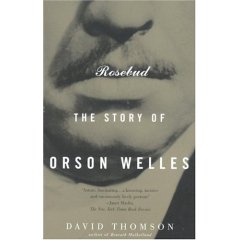Books I Love: “Rosebud: The Story of Orson Welles”

(This is the first in a series of posts to come introducing you to books that I’ve loved, with explanations why.)
Longtime readers of this blog already know that I’m a fan of the late, great filmmaker Orson Welles. This weekend I caught Welles’ last film, F for Fake, for the first time on cable (great movie, if you care) and the experience prompted me to pick up again a book I hadn’t read in a while: David Thomson’s biography “Rosebud: The Story of Orson Welles”.
Calling “Rosebud” a biography doesn’t really do it justice; the word probably conjures up in your mind images of monumentally dull thousand-page tomes. “Rosebud” is exactly the opposite: it doesn’t set out to recount every single event in Welles’ life. Instead, it uses lively prose to attempt to give you a flavor of the man’s personality, to give you a sense of what it must have been like to have been around him as he tore through Broadway, radio, and Hollywood.
This is an astute approach, because Welles’ story, more than most peoples’, is the story of his personality — both how it brought him fame and success and the price it exacted upon him. Welles was a visionary of such force and drive that by age 25 (!) he had been entrusted by a major studio with the resources to make his first film; and he used those resources to make Citizen Kane, still remembered as perhaps the single best movie ever.
The same drive that led him to the top, though, led him to alienate everyone around him; and the same voracious intellectual appetites that helped him to envision Kane drove him in so many directions at once that he would later become famous for never finishing his projects. By the time he died alone in 1985, he had become a kind of punchline, grossly overweight and earning a living pitching box wine and frozen peas on TV, a pale shadow of the dashing young visionary who had captivated and threatened Hollywood’s leading lights. After his death, though, a new generation discovered his work, and today he’s remembered among the great directors.
“Rosebud”, unlike most biographies, lingers not on Welles the man, but on the glory and tragedy of his life. Thomson’s prose, witty and erudite, is a pleasure to read. This biography is neither comprehensive nor academic; there are other works you can turn to if that’s what you’re looking for. What it is, though, is compelling, insightful, and just plain fun to read.
If you’re completely unfamiliar with Welles, you could do a lot worse than to start learning about the man and his work by reading “Rosebud”; it will give you a sense for why so many people (me included) are so fascinated by both, these many years later. And if you already know Welles, read the book anyway; you’ll discover whole new facets to the man’s life that you never appreciated before. Either way, “Rosebud” is a great take on a truly American story.

Comments
Ginger
September 7, 2006
12:58 pm
I recently read (in The Atlantic, which I credit you for getting me to subscribe to) that Orson Welles took off for Brazil to do some documentary for the government without doing any of the editing for the movie “The Magnificent Ambersons”. So the studio did it for him and just butchered the movie. I’ve never seen it, but I heard it was still pretty good. However, people have tried to piece together what it was like before it was all cut up, and they say it was even better than “Citizen Kane”. I think the author of the book you just reviewed even says “The Magnificent Ambersons” “would now be regarded as the greatest film ever made.” How sad for all of us that it didn’t survive. It’s like a masterpiece painting burning in a fire and only charred pieces remaining.
Jason Lefkowitz
September 7, 2006
1:27 pm
You’re right, Ginger. Welles spent much of the World War 2 period in Rio, shooting a film called “It’s All True”. He volunteered to do it as a part of a US Government program aimed at increasing Americans’ appreciation of their South American allies (Disney did a cartoon called “Saludos Amigos” for the same program). By all accounts, though, “It’s All True” was primarily an excuse for Welles to booze it up in Rio and tango with Latin women, who he always had a fondness for.
The studio’s demands to cut “Ambersons” came while Welles was off in Brazil, and for reasons known only to Welles, he chose to stay in Rio rather than return and fight. This despite pleading telegrams from friends and colleagues begging him to come back.
In fairness to the studio, it’s not hard to see why they would have been spooked by “Ambersons”. “Citizen Kane”, Welles’ previous film, had bombed at the box office amid complaints that it was too complicated for audiences to follow. (It didn’t start to be appreciated until fifteen years later.) And “Ambersons” was even more ambitious than “Kane”.
“Ambersons” was eventually released with the studio’s cuts; you can rent it today on DVD. It’s a good film, but the $64,000 question has always been how much better it could have been had Welles been able to keep it the way he’d shot it. We’ll never know.
And for double sadness points, he never finished “It’s All True”, either, despite shooting for practically all of World War 2.
And for TRIPLE sadness points, he managed to kill a Brazilian national hero in the process of filming “It’s All True”. One of his segments was a re-enactment of a famous long voyage by four Brazilian fishermen (“jangadeiros”), and he asked the four fishermen to play themselves. Shooting the big finish, a huge wave swamped their small boat and drowned their leader, Jacare.